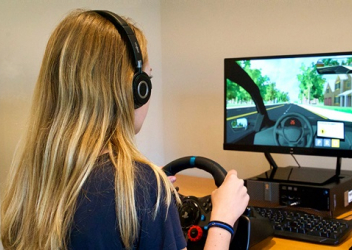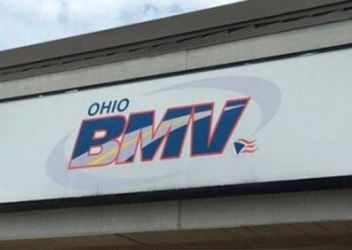Ohio Portable Driving Simulator System Pilot (PDSS)
From 2017-2019, CIRP researchers partnered with Diagnostic Driving, Inc., a Children's Hospital of Philadelphia (CHOP) spin-out company, and the Ohio Department of Public Safety (ODPS) to pilot and fully implement the Ohio Portable Driving Simulator System (PDSS) in State of Ohio Bureau of Motor Vehicles (BMV) licensing centers. The Ohio PDSS uses Diagnostic Driving, Inc.’s Ready-Assess™ software, which is implemented on standard desktop PCs using an inexpensive USB-steering wheel and pedals and placed in kiosks (or cubicles).
Diagnostic Driving and CIRP researchers worked closely with ODPS subject matter experts --primarily driving examiners--to contextualize a virtual driving assessment and optimize it for use in Ohio's licensing workflow. Ohio administers about 600,000 road tests per year.
Input from subject matter experts ensured that the State of Ohio BMV learner driver pilot driving assessment realistically represents Ohio driving and requires minimal time and staff input, relying instead on self-guided workflows. This was essential to minimize the disruption to busy licensing center workflows. Within nine months, PDSS was up and running in three licensing centers, collecting data on approximately 1,200 virtual driving skills assessments per month.
Self-Guided Workflow
In the self-guided workflow for the State of Ohio BMV learner driver pilot, each applicant spends less than 15 minutes with an orientation, an acclimation drive, and a randomized virtual driving test, receiving automated feedback on their driving.
Pilot Implementation and Results
- State of Ohio BMV Learner Driver Pilot Objectives
- Ease of integration into the workflow and software reliability
- Minimal staff management
- Applicants’ experience with it
- Identification of underprepared applicants without over-penalizing those who are ready to complete their on-road exam.
- Pilot Design and Workflow Integration
- The PDSS was integrated into the licensing workflow for new license applicants scheduled for their initial, non-commercial ORE regardless of age at five licensing centers.
- License applicants were administered the PDSS immediately before their initial ORE at selected State of Ohio BMV pilot exam centers.
- To not influence ORE results, all applicants and driving examiners were blinded to the PDSS results.
- All applicants took their ORE after taking the PDSS so that the scoring algorithm could be developed.
- The first 4,643 PDSS tests administered were linked with manually-transcribed ORE score sheets to identify those who would fail in order to develop a reliable scoring algorithm.
- The PDSS was highly scalable and easily expanded to a total of five exam facilities during the pilot.
- Highlights of State of Ohio BMV Learner Driver Pilot Results
- During the initial 14-month pilot period, approximately 20,000 PDSS tests were administered.
- Examiners and license applicants positively rated the PDSS as easy to use and incorporate into the licensing workflow.
- The technology was found to be reliable: <1 non-critical events per 1,000 PDSS tests administered and 0 critical events over nearly 4,500 hours of cumulative service time.
- The PDSS accurately detected underprepared applicants.
- Key PDSS performance errors were identified to be highly predictive of failing the ORE.
- State of Ohio BMV Learner Driver Pilot Design and Workflow IntegrationMore
The successful pilot allowed for a plan to be developed with six recommendations for the State of Ohio BMV to follow that other states may want to replicate. Ohio has implemented their new program as Ohio- Ready, Test, Drive!









